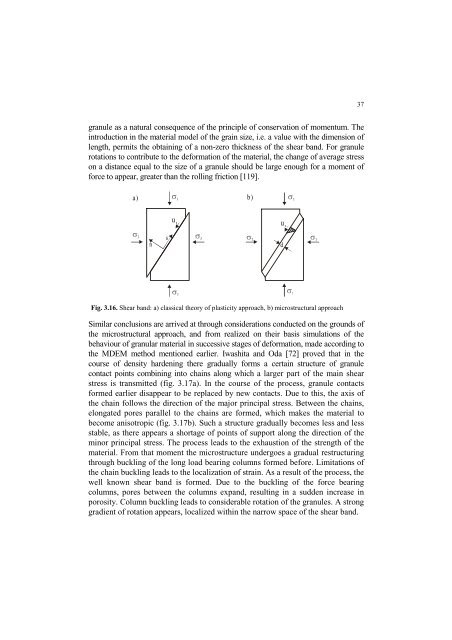Strona 2_redak - Instytut Agrofizyki im. Bohdana DobrzaÅskiego ...
Strona 2_redak - Instytut Agrofizyki im. Bohdana DobrzaÅskiego ...
Strona 2_redak - Instytut Agrofizyki im. Bohdana DobrzaÅskiego ...
You also want an ePaper? Increase the reach of your titles
YUMPU automatically turns print PDFs into web optimized ePapers that Google loves.
37<br />
granule as a natural consequence of the principle of conservation of momentum. The<br />
introduction in the material model of the grain size, i.e. a value with the d<strong>im</strong>ension of<br />
length, permits the obtaining of a non-zero thickness of the shear band. For granule<br />
rotations to contribute to the deformation of the material, the change of average stress<br />
on a distance equal to the size of a granule should be large enough for a moment of<br />
force to appear, greater than the rolling friction [119].<br />
a) b)<br />
u s<br />
u s<br />
n<br />
s<br />
d<br />
Fig. 3.16. Shear band: a) classical theory of plasticity approach, b) microstructural approach<br />
S<strong>im</strong>ilar conclusions are arrived at through considerations conducted on the grounds of<br />
the microstructural approach, and from realized on their basis s<strong>im</strong>ulations of the<br />
behaviour of granular material in successive stages of deformation, made according to<br />
the MDEM method mentioned earlier. Iwashita and Oda [72] proved that in the<br />
course of density hardening there gradually forms a certain structure of granule<br />
contact points combining into chains along which a larger part of the main shear<br />
stress is transmitted (fig. 3.17a). In the course of the process, granule contacts<br />
formed earlier disappear to be replaced by new contacts. Due to this, the axis of<br />
the chain follows the direction of the major principal stress. Between the chains,<br />
elongated pores parallel to the chains are formed, which makes the material to<br />
become anisotropic (fig. 3.17b). Such a structure gradually becomes less and less<br />
stable, as there appears a shortage of points of support along the direction of the<br />
minor principal stress. The process leads to the exhaustion of the strength of the<br />
material. From that moment the microstructure undergoes a gradual restructuring<br />
through buckling of the long load bearing columns formed before. L<strong>im</strong>itations of<br />
the chain buckling leads to the localization of strain. As a result of the process, the<br />
well known shear band is formed. Due to the buckling of the force bearing<br />
columns, pores between the columns expand, resulting in a sudden increase in<br />
porosity. Column buckling leads to considerable rotation of the granules. A strong<br />
gradient of rotation appears, localized within the narrow space of the shear band.
















